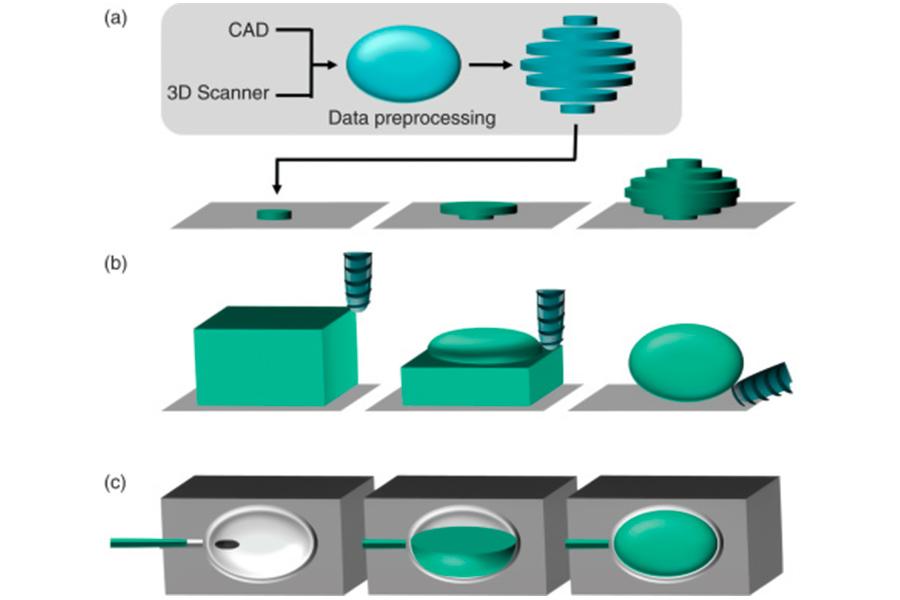Since its inception, rapid prototyping technology has become an indispensable tool in product development, design verification and manufacturing processes due to its efficiency, flexibility and accuracy. The core of this technology is to use computer-aided design (CAD) data to directly generate a three-dimensional solid model through layered superposition. The key to achieving this process lies in the various materials used. This article aims to explore the variousmaterials used inrapid prototyping, analyze their properties and their suitability for different applications.
What is Rapid Prototyping?
Rapid prototyping, in short, refers to the use of advanced manufacturing technology or design software in the early stages of product development to produce a preliminary model orrapid prototypeof the product at a lower cost and in a shorter time. Theserapid prototypes can be functional, cosmetic, or even a combination of the two and are used for testing, validating design concepts, evaluating user experience, presenting to investors, or marketing.
The principle is to continuously revise and improve product design through the cycle of "build-test-learn-feedback". Compared with the traditional product development process, rapid prototypingfocuses more on speed and flexibility, allowing designers and engineers to discover and solve problems early in product development and avoid costly and time-consuming modifications later.

What Materials Are Commonly Used in Rapid Prototyping?
Therapid prototype materialsofprototype modelsare unified into the following categories:
1.Plastics
Plastics are a common prototyping material as they are used in many fields and offer many advantages such as being durable, flexible, and cheap. They are synthetic polymers that can be molded into different shapes and sizes. This makes them ideal for manufacturing parts with complex geometries.
Plastics can beprototypedusing a variety of processes, including injection molding, 3D printing, and CNC machining. Forprototyping model, a variety of plastics can be used. The most common types of plastic are:
ABS (Acrylonitrile Butadiene Styrene):ABS is a plastic made from three main ingredients: acrylonitrile, butadiene, and styrene. It is a strong and durable plastic material commonly used to make toys, appliances, car parts, etc. It is known for its durability, heat and impact resistance. ABS plastic is cheap and easy to shape and process, making it a popular choice for 3D printing and injection molding.
PC (Polycarbonate):PC is a thermoplastic polymer with excellent strength, durability, and clarity. It is often used to make automotive parts, electronic components, safety equipment, bulletproof glass and other protective materials. Polycarbonate is also used to make 3D printing filaments because it is easy to mold and shape into complex shapes. It is a highly adaptable material that is impact and heat resistant, making it a popular choice for a variety of applications including automotive and aerospace.
PE (polyethylene):Polyethylene is a type of plastic known for its durability, flexibility, chemical resistance, and impact resistance. It is widely used in the manufacture of items such as packaging materials, containers and pipes, as well as in the manufacture of toys and other consumer products. Polyethylene is a versatile material that is easy to shape and process, making it the material of choice for injection molding and other manufacturing processes. It is also widely used to make 3D printing filaments due to its ability to be easily molded into complex shapes.
Nylon:is a synthetic polymer with high strength, durability, and abrasion resistance. It is widely used in the production of gears, bearings, automotive parts, textiles and other industrial materials. Since it can be easily molded and shaped into complex shapes, PA is also widely used to make 3D printing filaments. It is a versatile, durable and flexible material often used as an affordable alternative to silk, rubber and latex.
PP (Polypropylene):PP is a polyolefin or saturated polymer. PP is one of the most useful polymers, offering excellent chemical resistance, fatigue resistance, high temperature resistance, and lower density than HDPE. PP is a lightweight and flexible plastic commonly used in packaging, barrels, bowls, crates, toys, medical parts, automotive parts, washing machine drums, battery boxes and bottle caps. PP can be elastomer modified to make bumpers and filled with talc to make it harder at high temperatures.
Polyoxymethylene (POM):is a thermoplastic engineering material used to create parts with increased stiffness, low-friction versatility, and excellent dimensional stability. POM is strong and durable with high tensile strength, abrasion resistance, creep resistance, warpage resistance, toughness and durability. POM is widely used in the production of automotive parts, sports equipment, gears, bearings, conveyor parts, electrical components, sliding and guide components, etc.
PEEK (polyetheretherketone):PEEK is a colorless organic thermoplastic polymer. It is an engineering plastic that is used in a variety of applications requiring strength and toughness. PEEK is chemically resistant and can withstand temperatures up to 260°C.
2.Resins
Resin materials are mainly used for high-precision models in rapid prototyping, especially SLA (stereolithography) printing. Resin materials have excellent molding properties and surface quality, enabling products with complex geometries and fine details. Common resin materials include prototype acrylics, elastomeric polyurethane (EPU), flexible polyurethane, and color 3D printing resins such as VeroWhite and VeroClear.
3.Metals
Aluminum:Aluminum is a silvery, low-density metalused in a variety of commercial applications. For the most part, unalloyed aluminum is ductile, moderately strong, and extremely resistant to corrosion. The properties of aluminum can be greatly enhanced using the appropriate alloying elements (copper, magnesium, manganese, silicon, etc.) and subsequent heat/processing. Aluminum is widely used in aircraft, transportation, construction, food and chemical processing because of its low density and corrosion resistance.
Copper:Copper alloys are among the most useful metals because they resist corrosion, have high thermal conductivity, and conduct electricity well. Copper alloys are well suited for many electrical, construction, transportation and consumer goods industries. Copper is used to make building components, coins, condensers/heat exchangers, pipes, radiator cores, musical instruments, locks, fasteners, hinges, ammunition components, and electrical connectors.
Brass:Brass is an alloy of copper and zinc and has some of the same properties as copper. Brass is a durable, workable metal. The alloy is also corrosion-resistant, electrically conductive and has a low coefficient of friction. Brass is a versatile metal used in a variety of applications including plumbing, electrical, art and medicine.
Titanium:Considered the most precious metal, titanium performs well in harsh environments where other metals might fail. Titanium alloy is an alloy composed of titanium and other chemical elements. Titanium alloys are lightweight, have extremely high tensile strength and toughness, are resistant to corrosion, and can withstand extreme temperatures.
Alloy Steel:The main alloying element of alloy steel is not carbon. It contains small amounts of alloying elements such as manganese, silicon, nickel, titanium, copper, chromium and aluminum. Alloy steel is more corrosion-resistant, weldable, heat-resistant and ductile than carbon steel. But carbon steel is stronger than alloy steel. Due to their low cost, wide availability, ease of processing, and superior mechanical properties, alloy steels are commonly used in industrial applications, appliances, silverware, cookware, and automobiles.
Stainless Steel:Stainless steel is a steel alloy that is more corrosion resistant than carbon steel/alloy steel. 304, 316, 416, and 17-4 PH stainless steel grades are commonly used for CNC machining. Stainless steel is a strong material with a natural protective oxide layer, making it suitable for difficult situations. The alloy composition that makes up stainless steel grades makes them different.
Mild Steel:Mild steel is carbon steel with a lower carbon content. It is often referred to as "mild steel". Mild steels have lower tensile strength than high carbon and alloy steels because they contain less carbon and other alloying elements that prevent dislocations in the crystal structure. Mild steel is a common choice for consumer products due to its high weldability and workability.
Tool Steel:Tool steel is a carbon alloy steel. It is often used to make, modify or repair hand tools and machine molds. Tool steel is known for being hard, wear-resistant, and resistant to bending. Tool steel is often shaped into other materials by cutting, pressing, stamping or extruding it. This is because steel can maintain its cutting edge at extremely high temperatures. Tool steel is commonly used in impact applications such as stamping or extrusion dies, cutting, manufacturing dies and hammers.

What technologies are mainly used in rapid prototyping?
Rapidprototyping meaningplays an important rolein various fields, so what are therapid prototyping methods?
| Technology | Abbreviation | Materials | Advantage |
| Stereolithography | SLA | Thermoplastic-like photopolymers | High precision and excellent surface finish |
| Selective Laser Sintering | SLS | Nylon, TPU | No support structure required, suitable for a variety of materials |
| Fused Deposition Modeling | FDM | ABS, PC, PC/ABS, PPSU | Material versatility, ease of use and accessibility |
| Direct Metal Laser Sintering | DMLS | Stainless steel, titanium, chrome, aluminum, Inconel | High precision, high strength, suitable for functional parts and complex designs |
| Digital Light Processing | DLP | photosensitive resins | Fast, produce parts with excellent resolution and surface finish |
| Laminated Object Manufacturing | LOM | paper, plastics, and metal foils. | Low material cost, suitable for large parts production |
| Computer Numerically Controlled Machining | CNC | Most commodity and engineering-grade thermoplastics and metals | High precision and versatile materials. Ideal for producing parts with tight tolerances and intricate details |
| Multi Jet Fusion | MJF | Nylon | Produce strong parts with fine details and consistent mechanical properties |
How Do You Select Materials for Rapid Prototyping?
Here are some factors to consider when choosing materials for yourrapid prototyping process:
- Material properties: The various types of rapid prototyping materials exhibit unique properties, such as strength, flexibility and heat resistance. In many applications, such as when making molds and other products, these properties can be met. For example, when you are creating prototypes of mechanical parts, choosing a durable material like ABS can be a smart decision.
- Cost-Effectiveness: Budget plays a vital role when choosing materials. In many cases, material prices are one of the key factors that determine the success of a project investment. While materials that are efficiently and quickly produced may exhibit superior properties, they tend to be expensive to manufacture. If a suitable method can be found to reduce the production costs of these materials, it will bring huge benefits to companies. Ensuring a balance between costs and benefits is crucial.
- Intended use: Consider the functionality of the prototype. Prototype is a concept, which can also be understood as a technology or method, the purpose of which is to realize the design idea of specific functions by analyzing and comparing goals in different stages. Is it mainly used for functional testing and visual evaluation, or a combination of both?Prototypematerialsfor functional testing may require substances that are highly similar in properties to the final product.
- Layer thickness: The actual thickness of each layer during the 3D printing process. In general, the larger the layer thickness, the better the molding effect. This parameter will have a huge impact on the quality and accuracy of the prototype.
- Detail vs. print time: Thinner layer thickness helps achieve finer details and smoother surfaces, but this often results in longer print times. For some complex-structured printers, if they want to meet fast print output requirements, it is necessary to reduce the changes in the level of detail during the printing process. Finding a balance between ensuring the specific details required while managing the time constraints is critical.
- Support structures: For complex designs with overhanging features or complex geometries, support structures are often required. To achieve rapid manufacturing, a simple yet effective method is proposed to build temporary structures by directly converting 3D models into 2D graphics. These created temporary structures ensure stability during printing and avoid deformation of the 3D printing filament prototype.
- Stability and accuracy: Support structures ensure that your prototype maintains its structural integrity throughout the printing process, especially in areas with complex geometries, preventing issues such as sagging or warping.
- Removal after printing: It is important to note that the support structure must be removed after the prototype is completed, which may require additional work.
- Post-processing needs: Enhancing the final appearance and functionality of the prototype can often be achieved through post-processing techniques to improve the aesthetics and functionality of the prototype.

FAQs
1.What is the best material to prototype with?
The best materials for makingprototypesmainly include: ABS materials: commonly used materials for prototyping of conventional products, easy to process and beautiful; epoxy resin, phenolic resin, polycarbonate (PC), polyamide (nylon): suitable for applications that require high temperature resistancePrototyping; polyoxymethylene resin (POM) or polyamide (nylon): prototyping materials for wear-resistant products; nylon (PA) or polypropylene (PP): used to make high-toughness product prototypes; PMMA (acrylic), Transparent ABS and Transparent Polycarbonate (PC): Suitable for prototyping where transparency is required.
2.Which can be used for rapid prototyping?
Rapid prototyping techniquesoften rely on specific materials and processes. Resin or similar engineering plastics: suitable for SLA (stereolithography) technology, which can quickly produce prototypes of small and medium-sized workpieces; thin sheet materials (such as paper, metal foil, plastic film, etc.): used for LOM (layered solid manufacturing) technology, makingprototypesby cutting and stacking layer by layer; various powder materials: suitable for SLS (Selective Laser Sintering) technology, which uses laser scanning to melt the powder surface locally or partially, thereby completing single-level processing and forming layer by layer. Three-dimensional solid.
3.What materials are used in engineering prototypes?
Engineering prototypes often require materials to be selected based on specific application environments and functional requirements. Common engineeringprototypingmaterials mainly include metal materials: such as steel, aluminum, etc., used for engineering prototypes that require high strength and corrosion resistance; plastic materials: such as ABS, nylon, polycarbonate, etc., suitable for applications that require lightweight, Wear-resistant or transparent engineeringprototypes. Composite material: a new material composed of two or more materials with differentpropertiesthrough physical or chemical methods. It is suitable for engineering prototypes that require special properties (such as high strength, high toughness, high temperature resistance, etc.).
4.What are the materials used in prototype tooling?
Prototyping toolsgenerally refer to the equipment and materials used to make prototypes. ①Hand-drawing tools: such as pencil, eraser, white paper, etc., used to make hand-drawn prototypes. These materials are easy to obtain and suitable for the preliminary stages of prototyping. ②Software tools: Online prototyping and collaboration tools such as Axure and Ink Knife. When using these tools, theprototype materialsare mainly digital assets (such as pictures, icons, buttons, etc.). These assets can be edited and combined in the software to form a prototype. . ③3D printing materials: Plastic materials such as PLA and ABS, as well as metal powders, ceramic powders, etc., are used for 3D printing technology to make prototypes. These materials can be selected and adapted according to the needs of the prototype.
Summary
There are a wide variety of materials used inrapid mockup, each with its own uniquepropertiesand range of applications. When selecting materials, factors such as project needs, cost, processing efficiency, and environmental protection need to be comprehensively considered to ensure that a prototype that meets the requirements is produced. With the continuous advancement of technology and continuous innovation of materials, more high-performance, low-cost, and environmentally friendly material options will appear in rapid prototyping in the future.
Disclaimer
The content on this page is for reference only.LSdoes not make any express or implied representation or warranty as to the accuracy, completeness or validity of the information. No performance parameters, geometric tolerances, specific design features, material quality and type or workmanship should be inferred as to what a third party supplier or manufacturer will deliver through the Longsheng Network. It is the responsibility of the buyerseeking a quote for partsto determine the specific requirements for those parts.Pleasecontact usfor moreinformation.
LS Team
This article was written by multiple LS contributors. LS is a leading resource in the manufacturing sector, withCNC machining,sheet metal fabrication,3D printing,injection molding,metal stamping, and more.





